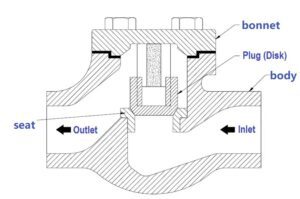
If there are no measures or devices in place in a pipeline, the fluid inside may flow backward once the driving force is lost, which can cause various problems. To prevent this, a device is needed at different points in the pipeline to stop the fluid from flowing back, ensuring the safety and stability of the entire system. The check valve is designed to meet this need. It allows fluid to flow in only one direction and prevents reverse flow. There are many types of check valves, and today we are focusing on the lift check valve.
A lift check valve has an internal structure with a disc that can move up and down vertically and a seat that matches it. These parts work together to let fluid flow in the intended direction. When fluid tries to flow backward, the disc falls down due to gravity and seals tightly against the seat, stopping the reverse flow. The higher the pressure on the disc, the better the seal. Because of this unique design, lift check valves are widely used in various high-pressure industrial pipelines.
The lift check valve is a one-way valve mainly used to prevent reverse flow in pipeline systems. When fluid flows in the forward direction, the disc lifts up due to fluid pressure, allowing the fluid to pass through. If the fluid tries to reverse, the disc falls down under gravity and reverse fluid pressure, sealing against the seat and blocking the backflow. Thanks to this design, lift check valves perform excellently in high-pressure, high-flow environments and are widely used in industrial pipeline systems.
The name “lift check valve” gives a clue to how it works. It controls fluid flow by using an internal lifting mechanism. Here’s a detailed explanation of how it operates:
When the fluid flows through the pipeline in the intended direction, it creates pressure as it passes through the valve body. This pressure pushes the internal disc upwards, creating a space between the disc and the seat for the fluid to pass through. The greater the fluid pressure, the higher the disc lifts. Since the disc moves vertically, the lift check valve offers relatively low resistance to the fluid flow in this normal direction.
As the fluid flow decreases, the pressure on the disc reduces. The disc then quickly moves downwards due to gravity and the reverse fluid pressure, forming a seal with the seat to prevent backflow. When there is no fluid movement or the fluid flow in the pipeline stops completely, the disc remains closed due to its own weight. This ensures that the fluid can only move in the intended direction, maintaining the stability and safety of the entire pipeline system and protecting other equipment from damage.This automatic closing feature makes lift check valves widely used in various industrial pipelines.

Preventing Backflow: The main role of a lift check valve in a pipeline system is to prevent the backflow of fluid. As explained earlier, it works by allowing fluid to flow in only one direction. Because of this feature, lift check valves are widely used in water supply lines, petrochemical pipelines, and steam systems.
Protective Function: When installed at the outlet of pumps, compressors, or other equipment, lift check valves can prevent reverse fluid flow if the equipment suddenly stops or fails. This helps protect the equipment from damage. For example, in a water supply system, if the main pump suddenly stops, the lift check valve stops water from flowing back, preventing damage caused by reverse flow to the pump and the pipeline.
Maintaining Pipeline Stability: Lift check valves help maintain the stability of the pipeline system by stopping reverse flow and reducing the impact of backflow. In some cases, they can also prevent water hammer effects in the pipeline, ensuring the system remains stable.
Suitable for High-Pressure Pipelines: Due to their design, lift check valves are ideal for high-pressure systems. The greater the fluid pressure, the better the seal, making them reliable and stable even in pipelines with very high pressure.
Lift check valves are widely used in various pipeline systems due to their unique design. Their main application scenarios include:
Petroleum and Chemical Industry: In these industries, lift check valves are commonly used to control the unidirectional flow of fluids. They prevent harmful or expensive media from flowing back, which could cause environmental pollution or economic loss.
Power Industry: In power plants, lift check valves are used in boiler feedwater systems and steam pipelines to prevent high-pressure fluid from reversing. This helps protect critical equipment such as turbines and pumps.
Water Supply Systems: In water supply systems, lift check valves are used to prevent backflow when the water pump stops, protecting the pipeline from contamination.
Steam and Hot Water Systems: In these systems, lift check valves are used to prevent the reverse flow of condensate or steam, ensuring the safety of boilers and pipelines.
Pharmaceutical and Food Industry: In these industries, lift check valves ensure unidirectional fluid flow, preventing cross-contamination and ensuring product quality and safety.
High-Pressure Systems: In systems requiring high-pressure operations, such as oil and gas pipelines, lift check valves provide reliable check functions to prevent backflow of the medium.
The lift check valve is a specialized type of check valve with a unique disc and seat design that provides effective backflow prevention. It plays a crucial role in pipeline systems across various industries by controlling the unidirectional flow of fluids. By allowing flow in only one direction, it protects the system’s safety and ensures the proper operation of equipment. Additionally, it maintains system stability, offering reliable support for various industrial applications.